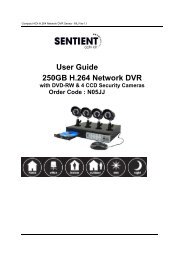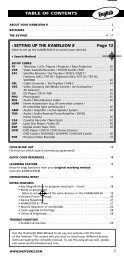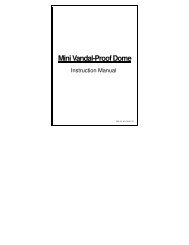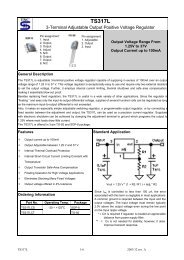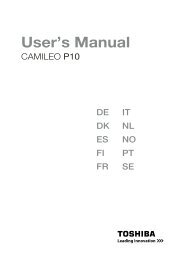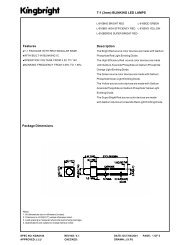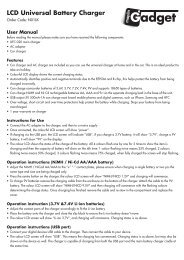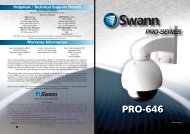KMD10 product manual - Maplin Electronics
KMD10 product manual - Maplin Electronics
KMD10 product manual - Maplin Electronics
Create successful ePaper yourself
Turn your PDF publications into a flip-book with our unique Google optimized e-Paper software.
Specifications<br />
General<br />
Frequency Response 10Hz - 60KHz +/-2db<br />
T.H.D. 0.01% @ +4dbU/1KHz<br />
Signal To Noise Ratio Amplifier on & DSP on ? 70dB (-2dB)<br />
Amplifier off & DSP on ? 75dB (-2dB)<br />
Amplifier on & DSP off ? 72dB (-2dB)<br />
Amplifier off & DSP off ? 77dB (-2dB)<br />
Power Dual PSU 115V/230V<br />
Amplifier<br />
2 x 200W RMS/2 x 400W Peak @ 8 Ohms<br />
2 x 350W RMS/2 x 700W Peak @ 4 Ohms<br />
Mixer<br />
20 inputs - 6 x mic/line, 14 line<br />
Electronically Balanced Inputs accept balanced or unbalanced sources<br />
Gain Range +10db to +44db<br />
Mic Channel EQ Hi +/-15dB @ 12kHz<br />
Swept Mid +/-15dB @ 100 Hz to 8kHz<br />
Lo +/-15dB @ 80Hz<br />
Mic Channel Lo Cut Filters 18dB per octave @ 75Hz<br />
Line Channel EQ Hi +/-12dB @ 12kHz<br />
Hi Mid +/-15dB @ 3kHz<br />
Lo Mid +/-15dB @ 500Hz<br />
Lo +/-12dB @ 80Hz<br />
2 x Aux Send & Return switched +4dBu & -10dBV operation<br />
Aux 1 switched Pre/Post Fade<br />
Channel Level Faders 60mm : +7dbU to -60dbU<br />
7 Band Graphic EQ +/-10dB @ 60Hz, 160Hz, 410Hz, 1.1kHz, 2.3kHz,<br />
6.2kHz , 15.6kHz<br />
Effects<br />
A/D D/A Conversion 20BIT<br />
Sampling Rate 46kHz<br />
Dimensions<br />
<strong>KMD10</strong> 535W x 410D x 185H (mm)<br />
Weight<br />
<strong>KMD10</strong> 18.5kg<br />
www.kam.co.uk<br />
<strong>KMD10</strong><br />
<strong>product</strong> <strong>manual</strong><br />
www.kam.co.uk
<strong>KMD10</strong><br />
<strong>product</strong> <strong>manual</strong><br />
Overview<br />
Thank you for purchasing your new Kam <strong>KMD10</strong> Mixing Console.<br />
The <strong>KMD10</strong> is designed to serve a wide range of uses for Live Sound,<br />
Install or Project Studio. Like all Kam <strong>product</strong>s it is designed to offer<br />
professional features and high quality manufacturing that deliver<br />
outstanding value for money.<br />
Key Features<br />
2 x 200W RMS/2 x 400W Peak Amplifier<br />
10 channels/20 inputs : 6 x mic/line & 14 line<br />
Built in 20BIT DSP Effects System<br />
7 Band Master Graphic EQ<br />
Electronically balanced inputs<br />
Inserts on Mic Channels, Master & Alt 3&4<br />
3 band swept & 4 band channel EQ<br />
2 x Aux Send & Return System (pre/post)<br />
Full Mute/Alt 3&4 sub mix system<br />
Fully routable Control Room system<br />
Professional PFL/Solo system<br />
Independent Amp inputs & PSU<br />
Positioning<br />
When using the built in amplification it is important not to block the<br />
air intake vents on the rear panel. These are essential for the dual<br />
speed fans to keep the unit cool during operation.<br />
Avoid exposing the unit to rain or excessive levels of humidity during<br />
operation.<br />
[1] IEC main power inlet connector - use this standard IEC connector<br />
to connect the <strong>KMD10</strong> to the mains. This inlet supplies mains power<br />
to both the Mixer and Amplifier Sections of the unit.<br />
[2] Mixer Main Power switch - use this switch to turn on & off the<br />
mains power supply to the Mixer section ONLY of the <strong>KMD10</strong>.<br />
The Amplifier section has its own dedicated power switch [54].<br />
54<br />
1<br />
The 'Channel Strips'<br />
Rear Panel<br />
2 4<br />
[3]. XLR Input (Mic Channels 1 to 6 only). Use this mic level XLR input<br />
to connect your microphone. You can use dynamic or condenser<br />
microphones with the <strong>KMD10</strong>. You cannot use this XLR connection<br />
for line level audio signals.<br />
[4] Phantom Power switch - the <strong>KMD10</strong> Mic inputs feature a 48V<br />
Phantom Power system to facilitate use of Condenser Microphones<br />
that require an external power source. To use; move the switch<br />
marked 'Phantom' (found on the rear panel) to the on position and<br />
Phantom Power will be delivered to all six XLR mic' input connectors.<br />
There should be no adverse effects using a mixture of powered<br />
Condenser mic's and standard dynamic mic's simultaneously… the<br />
dynamic mic's should not be effected by the Phantom Power<br />
supply. When the Phantom Power system is active you should see<br />
the +48V red status LED [60] in the Main Level Meter LED area<br />
illuminated.<br />
[5]. Line Input (Mic Channels 1 to 6 only). Use this 1/4” jack sockets to<br />
attach any line level audio source (keyboard, CD player etc).<br />
This socket is electronically balanced so accepts either a balanced<br />
or unbalanced audio signal and automatically self adjusts<br />
accordingly.<br />
[6] Channel Insert connections (Channels 1 to 6 only) -<br />
the microphone channels feature an 'Insert' system. These are<br />
commonly used to connect automatic gain control devices such as<br />
Compressors and noise Gates (like the Kam KCG100 combined<br />
Compressor/Gate). The Insert system follows industry standard<br />
protocol. To use it you will need a specially configured 'Y Insert<br />
Cable'. These cables have a single TRS 1/4” jack connector at one<br />
end and a pair of standard mono TS 1/4” jack connectors at the<br />
other. To use the system you connect the single TRS connector to the<br />
appropriate 'Channel Insert' connection found on the rear panel of<br />
the unit. Although the TRS connector used here is physically the<br />
same as that used for a stereo audio connection (commonly used<br />
for headphones) in this context it is wired very differently internally.<br />
TRS actually stands for 'Tip', Ring', 'Sleeve'; which in turn refers to the<br />
fact that the shaft of the connector is split into three isolated<br />
sections. The Tip section is wired to one of the two mono connectors<br />
of your 'Y Insert Cable' and this is used as a signal Send (which you<br />
connect to the input of your processor). The middle or 'Ring' section<br />
is wired to the other mono connector and this is used as a signal<br />
Return (which you connect to the output of your processor).<br />
The 'sleeve' section is used as a ground connection.<br />
Rear<br />
Panel<br />
[7]. L (mono) & R line inputs (Line Channels 7 to 10 only) - use these<br />
unbalanced 1/4” jack sockets to connect any line level audio<br />
source. Use the L input when you wish to attach a mono source (EQ<br />
a vintage synthesiser) as this socket is automatically split and sent to<br />
both L&R channels of the main mix when there is no connection to<br />
the R input. Use both connections when connecting a stereo source<br />
(EG a CD player).<br />
[8]. Lo Cut switch (Mic Channels 1 to 6 only). This button applies an<br />
18dB per octave High Pass filter that completely removes all<br />
frequencies below 75Hz. We highly recommend using this filter for<br />
hand held vocal microphones because it eliminates handling noise.<br />
It is also worthwhile using it for any microphone or instrument that is<br />
not intended to produce bass because it also reduces the chances<br />
of low frequency feedback and can deliver an overall mix with<br />
greater clarity.<br />
[9]. Gain - Use this control in conjunction with the PFL system & the<br />
level meters to adjust the input signal level so that it peaks at around<br />
the 0dB mark on the level meter. You will notice two different sets of<br />
calibration around the control. This is because the gain circuit<br />
applies a different amount of gain to the microphone and line<br />
inputs.<br />
The +4 marking corresponds to the 'unity' setting for a signal at the<br />
standardised professional line level of +4dBu. The -10 marking<br />
corresponds to the 'unity' position for a standard domestic line<br />
level -10dBu signal. These two markings are there to show you where<br />
to position the gain control so that the gain circuit is neither<br />
increasing nor decreasing the signal level for each different line level<br />
signal type.<br />
6<br />
Settings Drawing<br />
'TIP - Photocopy this diagram of the mixer controls a few times and then use the copies to mark down the settings of the controls... So that you can quickly and easily return the controls to<br />
their current settings. It is very useful when you have several bands performing... Just note down the settings at the end of each bands sound check.'
Alt 3&4<br />
The Alt 3&4 System is a powerful 'routing system' that enables you to<br />
set up a second separate mix to the main mix that can be used for<br />
recording or setting up stage monitors or simply as a traditional<br />
'Sub Mix'. The classic use for a traditional sub mix is to route all of the<br />
microphones on a drum kit, or all the microphones for a brass<br />
section, or all the microphones used for backing vocals to a single<br />
fader; so that you can adjust the entire group with one<br />
fader movement.<br />
Any channel that is routed to the Alt 3&4 System via its Alt 3&4<br />
button is removed from the Main Mix and sent instead to a set of<br />
line level 1/4” jack connections on the rear panel marked 'Alt 3& 4<br />
Outputs' [48].<br />
Before the signal gets to those rear panel outputs it goes via the<br />
fader in the master section marked 'Alt 3&4' [49] - you use this fader<br />
to adjust the combined level of all of the channels you have<br />
currently selected to route to the Alt 3&4 system.<br />
There is a button above the fader marked Alt 3&4 to Mix [50] that<br />
simultaneously routes the 'Alt 3&4 Mix' back to the main mix (Post<br />
Fader) so that you have the option of routing the selected channels<br />
to this additional 'Sub Mix' and sending it onwards to the Alt 3&4<br />
outputs but without also losing it from the Main Mix.<br />
There is a button marked 'Alt 3&4 PFL' [51] that routes the entire<br />
Alt 3&4 Mix to the PFL/Solo System & Main Level Meter for<br />
measurement etc.<br />
There is a button beside the Control Room Level [45] that routes the<br />
combined Alt 3&4 Mix to the Control Room System.<br />
[52] Alt 3&4 Insert connections - these TRS 1/4” jack sockets are Insert<br />
connection points for the Alt 3&4 output connections. They function<br />
in exactly the same manner as the Channel Inserts [6].<br />
[53] Phones - use this standard headphone connection socket to<br />
attach a set of headphones for monitoring purposes.<br />
2 4 31<br />
54<br />
1<br />
55<br />
33<br />
34<br />
32<br />
Rear Panel<br />
The Amplifier<br />
[54] Amplifier Mains Power switch - use this switch to turn the<br />
Amplifier on & off independently of the mixer section.<br />
[55] Mains Voltage selector - use this recessed switch to select the<br />
appropriate mains operating voltage for your country.<br />
[56] Input connectors - use these line level 1/4” jack sockets to<br />
connect an input audio signal to the built in Amplifier.<br />
If you want to Amplify the signal from the <strong>KMD10</strong> mixer you will need<br />
to use a pair of cables to connect one of the various audio output<br />
connections (usually one of the various 'Main Mix' output<br />
connections) to these Amplifier Input connectors.<br />
[57] Amplifier Input Level controls - use these L&R rotary Level<br />
controls to adjust the overall listening level of any speakers<br />
connected to the <strong>KMD10</strong> Amplifier Speaker Outputs.<br />
[58] Speakon Type Speaker Output connectors - use appropriate<br />
cables to connect these Speakon Type Speaker Output connectors<br />
to the Input Connections of your speakers. Speakon is the industry<br />
standard connection method for connecting speakers to power<br />
amplifiers; it is safe, secure and delivers superior audio fidelity.<br />
[59] Binding Post Speaker Output connectors - use appropriate<br />
cables to connect these Binding Post Type Speaker Output<br />
connectors to the Input Connections of your speakers. Binding Posts<br />
are designed to accommodate bare wire ends of speaker cables;<br />
this is a legacy speaker connection method which although safe<br />
and reasonably secure when handled correctly and capable of<br />
delivering good quality audio fidelity… and undeniably convenient<br />
in the sense that any speaker cable can rapidly be turned into a set<br />
of bare wires in an emergency… is not our recommended<br />
connection method. We really would prefer you used Speakon.<br />
NOTE* The <strong>KMD10</strong> has a rated power output that delivers the<br />
following;<br />
2 x 200W RMS @ 8 Ohms 2 x 350W RMS @ 4 Ohms<br />
Be sure to match the rated power handling capacity of your<br />
speakers to the <strong>KMD10</strong> power output to avoid damaging your<br />
speakers.<br />
Rack Mounting<br />
To rack mount the <strong>KMD10</strong> remove the * screws on the outside edge<br />
of each of the plastic side cheeks. Slide the handle and side cheeks<br />
off to reveal the rack ears.<br />
59<br />
58<br />
Amplifier Panel<br />
48 52 6<br />
57<br />
56<br />
11<br />
13<br />
14<br />
3<br />
9<br />
15<br />
17<br />
19<br />
5<br />
Mic<br />
Channel<br />
8<br />
10<br />
12<br />
16<br />
18<br />
7<br />
Line<br />
Channel<br />
[10] EQ. The mic channels (1-6) and line channels (7-10) feature<br />
different types of EQ system.<br />
The Mic Channels - feature 3 band EQ with a swept mid control. The<br />
Hi control applies +/-15dB of cut and boost to all frequencies above<br />
12kHz. The Lo control applies +/-15dB of cut or boost to all<br />
frequencies below 80Hz. The mid section has two controls; the upper<br />
control sets whether you cut or boost by +/-15dB. The lower control<br />
lets you choose which mid range frequency you cut/boost. As with<br />
all mid range EQ systems you are effectively adjusting a 'notch' or<br />
'band' of frequencies above and below the selected 'centre'<br />
frequency.<br />
The Line Channels - feature 4 band EQ. The Hi control applies +/-<br />
12dB of cut and boost to all frequencies above 12kHz. The Hi Mid<br />
control applies +/-15dB of cut or boost to a 'band' of frequencies<br />
above and below 3kHz. The Lo Mid control applies +/-15dB of cut or<br />
boost to a 'band' of frequencies above and below 500Hz.<br />
The Lo control applies +/-12dB of cut or boost to all frequencies<br />
below 80Hz.<br />
[11] Aux 1 'Aux' - use this control to set the amount of signal sent to<br />
the line level audio output marked 'Aux Send' in the master<br />
connections section. How to set up the Aux Send & Return system is<br />
explained below under Master Connections.<br />
[12] Pre button - this button relates to the Aux control. When the<br />
button is 'down' the signal from this channel is sent to the Aux output<br />
connection before it reaches the channel level fader - so adjusting<br />
the channel level fader has no impact on the Aux Send level. When<br />
the button is in the 'up' position the signal from the channel is routed<br />
to the Aux Send connection after it has passed through the channel<br />
level fader - so when the button is 'up' turning down the level fader<br />
also turns down the signal sent to the Aux Send. This is useful when<br />
using the Aux Send system to set up an on stage monitor mix as it<br />
enables creation of a separate mix with levels that differ from those<br />
of the main mix.<br />
[13] Aux 2 'FX' - use this control to adjust the signal level sent to the<br />
on board effects processor. To aid versatility the <strong>KMD10</strong> also provides<br />
a line level output marked 'EFX Send' in the master connections<br />
section. This output can be used to connect an external effects<br />
processor instead of the on board processor. The 'EFX Send' is wired<br />
'Post Fade' so adjusting the channel level fader also adjusts the EFX<br />
Send level (to both the on board Effects Processor and the external<br />
EFX Send connection).<br />
[14] Pan - when this control is in the central position equal<br />
proportions of the channel signal is sent to the Left and Right<br />
channels of the main mix. Turn the control left and more signal will<br />
be sent to the Left channel of the main mix. Turn the control to the<br />
right and more signal will be sent to the Right channel of the main<br />
mix.<br />
[15] PFL/Solo - this button sends the channel audio signal to the<br />
PFL/Solo system (described in the PFL/Solo section of this <strong>manual</strong>).<br />
The signal is sent 'Pre Fade' and pre EQ so the measured signal is not<br />
changed by the position of the channel level fader or the EQ<br />
controls… but the signal IS taken immediately after the<br />
channel Gain control (and thus the Insert Sockets), so you are<br />
essentially measuring the input signal level after you have adjusted it<br />
with the input Gain control.<br />
[16] Peak LED - this LED illuminates when the channel signal level is<br />
approaching a level at which it may distort. It is there to act as a<br />
warning to you that you may need to reduce the particular<br />
channels level fader to avoid distortion.<br />
[17] Mute/Alt 3&4 - this button performs two tasks at once when<br />
pressed.<br />
1. It mutes (silences) the channel from the main mix.<br />
2. It routes the signal to the Alt 3&4 System<br />
(as described in the 'Alt 3&4' section of this <strong>manual</strong>).<br />
[18] Alt 3&4 LED - when the Alt 3&4 button is engaged this amber<br />
LED illuminates to remind you that you have routed this particular<br />
channel into the Alt 3&4 system.<br />
[19] Channel Fader - use this 60mm fader to adjust the relative level<br />
of the channel in the main mix.
The Aux & Effects Systems<br />
About using an Aux System<br />
The idea of an Auxilliary Send & Return system is that it enables you<br />
to send a signal out of the mixer, off to an external processor (usually<br />
it is an effects unit), through the external processor, then back to the<br />
mixer… and back into the main mix. The on board Effects Processor<br />
on the <strong>KMD10</strong> is accessed exactly as though it were an external<br />
processor. When you wish to send sound to it you use the 'Aux 2 EFX'<br />
Send & Return system. Aux 2 EFX also features Send & Return<br />
connections so can be used with an external Effects processor<br />
should the need arise. The descriptions of all connections etc below<br />
apply therefore to both 'Aux1' & 'Aux2 EFX'.<br />
[20] Aux Send connections - use a cable to connect from this mono<br />
line level 1/4” jack socket to the input of your external processor.<br />
[21] Master Aux Send Level controls - use these to set the Master<br />
Send Level for the Aux Send System. These controls set the overall<br />
level of all of the signals sent to the Aux Send & Return systems via<br />
the Aux Send controls in the channel strips.<br />
[22] Aux Send PFL buttons - press these buttons to route either Aux<br />
Master signal to the main Level Meter (and Solo it) so that you can<br />
measure it (and hear it isolated). Many External Effects processors<br />
do not have input level meters so it is wise to periodically measure<br />
the Send Level signal to ensure that the signal is neither too large nor<br />
too small.<br />
[23] Aux Return connections - use a pair of cables to connect<br />
these line level 1/4” jack input sockets from the output your external<br />
processor to your mixer.<br />
[24] Aux Return input level switches - use these buttons to determine<br />
whether each Aux Return connection operates at either the<br />
Professional Line Level Standard of +4dBu or the Domestic Line Level<br />
Standard of -10dBV.<br />
[25] Aux Return Level faders - use these faders to set the relative<br />
level of the Return signal (from your external processor) of the Aux<br />
Send & Return Systems in the main mix.<br />
The On Board Effects<br />
The <strong>KMD10</strong> on board Effects System provides a carefully selected<br />
range of 32 high quality Effect Programs. They are designed to be as<br />
versatile as possible and to meet your requirements for a wide range<br />
of uses. Operation is also extremely simple.<br />
[26] Program LED - this large two digit LED display shows the currently<br />
selected Effect Program.<br />
[27] Up & Down buttons - use these increment buttons to select the<br />
Effect Program you wish to use from the list. Press either button once<br />
to move up or down through the list.<br />
[28] Mute button - use this button to temporarily switch off the<br />
Effects. Press the button once more to switch the Effects back on.<br />
Front<br />
Panel Inputs<br />
46<br />
41 35<br />
[29] Effects Input Level Meter - this meter automatically displays a<br />
measurement of the signal arriving at the input of the Effects<br />
Processor. Because you are able to route signals from a large<br />
number of channels to the Effects it is easy to overload the Effects<br />
Processor. Digital distortion caused by excessive signals can be an<br />
unpleasant sound so we suggest regular observation of this Level<br />
Meter.<br />
[30] EFX Processor Direct In - in addition to routing signals to the on<br />
board Effects Processor you can use these line level 1/4” jack input<br />
connections to route external signals directly into the Effects<br />
Processor. When you do this the signal passes through the Processor<br />
and arrives in the main mix via the EFX Return Level fader [26]<br />
The Master Section<br />
The Master Section of the <strong>KMD10</strong> is extremely versatile and highly<br />
specified for a mixer in this class. There are various ways in which you<br />
can connect and use this <strong>product</strong>.<br />
Main Mix<br />
There are three sets of Main Output connections which all<br />
simultaneously carry the full stereo main mix.<br />
[31] XLR R&L - these two line level balanced XLR connectors<br />
(found on the rear panel) are your primary outputs, they are the<br />
least prone to interference because they of a balanced XLR type.<br />
[32] Master Insert connections - these TRS 1/4” jack sockets are Insert<br />
connection points for the Master output connections. They function<br />
in exactly the same manner as the Channel Inserts [6].<br />
[33] XLR Level switch - use this switch to determine whether the Main<br />
XLR Output Connectors [31] operate at either the Professional Line<br />
Level Standard of +4dBu or the Domestic Line Level Standard<br />
of -10dBV.<br />
[34] Rear Panel Main Outputs - these line level 1/4” jack connectors<br />
carry the stereo main mix and can be used for a variety of purposes.<br />
[35] Top Panel Main Outputs - these line level 1/4” jack connectors<br />
carry the stereo main mix and can be used for a variety of purposes.<br />
[36] Main Mix L&R Level Faders - each of these two faders controls<br />
the Level of one side of the stereo main mix as sent to all of the<br />
various connectors that carry the main mix.<br />
Graphic Equializer<br />
The 7 band Graphic Equaliser is only applied to the main mix.<br />
[37] EQ In - this button switches the Graphic Equaliser on and off.<br />
[38] EQ Frequency faders - five of these faders (the ones marked<br />
160Hz, 410Hz, 1.1kHz, 2.3kHz & 6.2kHz) relate to a narrow band of<br />
frequencies. When placed at the calibrated 'zero' position they<br />
have no effect, but when pushed up or pulled down they cut or<br />
boost the relevant band of frequencies by +/- 10dB. The faders at<br />
either end are a little different, they are 'shelving filters'; the lower<br />
one cuts & boosts all frequencies below 60Hz (IE bass) and the<br />
upper one cuts & boosts all frequencies above 15.6kHz<br />
(IE high treble & hiss).<br />
30<br />
20<br />
23<br />
23<br />
24<br />
The Main Level Meter [39]<br />
This 'enclosed bar type', back-lit, 3 colour, stereo level meter<br />
provides an accurate audio signal level measuring tool. It can be<br />
used to measure a broad range of signals. When the PFL & Solo<br />
status indicators remain un-illuminated the meter will be measuring<br />
the stereo signal of the Main Mix. When either the PFL or Solo status<br />
LEDs are illuminated the meter will be measuring a signal source you<br />
have selected by pressing one of the many PFL/Solo buttons found<br />
throughout the Mixer.<br />
An optimum signal level is one where the meter peaks regularly at<br />
around the 'zero' dB calibrated segment (at the top of the green<br />
coloured section). It is perfectly acceptable for the meter to be<br />
peaking in the amber sections of the meter, but they are coloured<br />
amber for a reason; they are there to warn you that you are<br />
approaching the red segment. If the meter is peaking at the red<br />
segment your sound is probably 'clipping' and sounding distorted<br />
and should probably be turned down.<br />
PFL/Solo<br />
[40] PFL/Solo button - this button switches the PFL Solo<br />
system between its two different operating modes.<br />
When in the 'up' or 'PFL' position; the <strong>KMD10</strong> routes any<br />
selected signals to the main Level Meter [39] so that<br />
they can be measured. The amber PFL status Led in the<br />
Main Level Meter area also illuminates.<br />
When in the 'down' or 'Solo' position; in addition to<br />
routing the signal to the Main Level Meter, the mixer<br />
mutes ALL of the channels and inputs to the <strong>KMD10</strong> so<br />
that you only hear the individual channel(s) selected<br />
via PFL/Solo buttons. The Solo LED in the master section<br />
also illuminates.<br />
You can actually press the PFL/Solo buttons for several<br />
channels/sources at once… meaning that you can<br />
listen to how several channels/sources sound together<br />
isolated from the rest of the mix… and/or measure their<br />
signal levels in isolation.<br />
Control Room<br />
The <strong>KMD10</strong> features a traditional 'Control Room' system.<br />
In a recording studio this is often used for connection of<br />
the Mixing Console to the Monitor System (speakers)<br />
used by the recording engineer. Its main purpose is to<br />
provide a convenient routing and level control system<br />
for the engineer to use.<br />
[41] Control Room connections - use an appropriate<br />
audio cable to connect these line level 1/4” jack<br />
connectors to the audio input for whichever speakers<br />
are to be used by the mix engineer.<br />
[42] Control Room Level control - use this rotary control<br />
(conveniently located on the front panel near the Main<br />
Mix Level faders) to adjust the signal level sent via the<br />
Control Room System outputs.<br />
Located around the Control Room Level Control you will<br />
find three buttons; each of these buttons routes a<br />
different audio source to the Control Room output<br />
connections. The three options for routing to the Control<br />
Room system are [43] Main Mix (which is the main<br />
stereo mix), [44] 2 Track (which is the signal from the<br />
2Track Input) and [45] Alt 3&4 (which is the signal from<br />
the Alt3&4 system).<br />
Master Section<br />
22<br />
27<br />
2-Track<br />
The 2-Track system is designed for recording, particularly recording<br />
at a gig.<br />
[46] 2-Track connections - use these unbalanced line level RCA type<br />
connections to attach your recording device. Connect the L&R set<br />
marked 'Tape In' to the Record Input sockets of your recording<br />
device. Connect the L&R set marked 'Tape Out' to the Output or<br />
Playback sockets of your recording device.<br />
[44] 2-Track to Control Room - use this button to route the signal from<br />
the 2-Track 'Tape Out' connectors to the Control Room system<br />
output.<br />
[47] 2-Track to Main Mix - use this button to route the signal from the<br />
2-Track 'Tape Out' connectors to the Main Mix Level Faders and<br />
various Main Mix output connections.<br />
26<br />
21<br />
25<br />
38<br />
28<br />
29<br />
44<br />
45<br />
50<br />
37<br />
42<br />
39<br />
49 36<br />
40<br />
51<br />
43<br />
51



